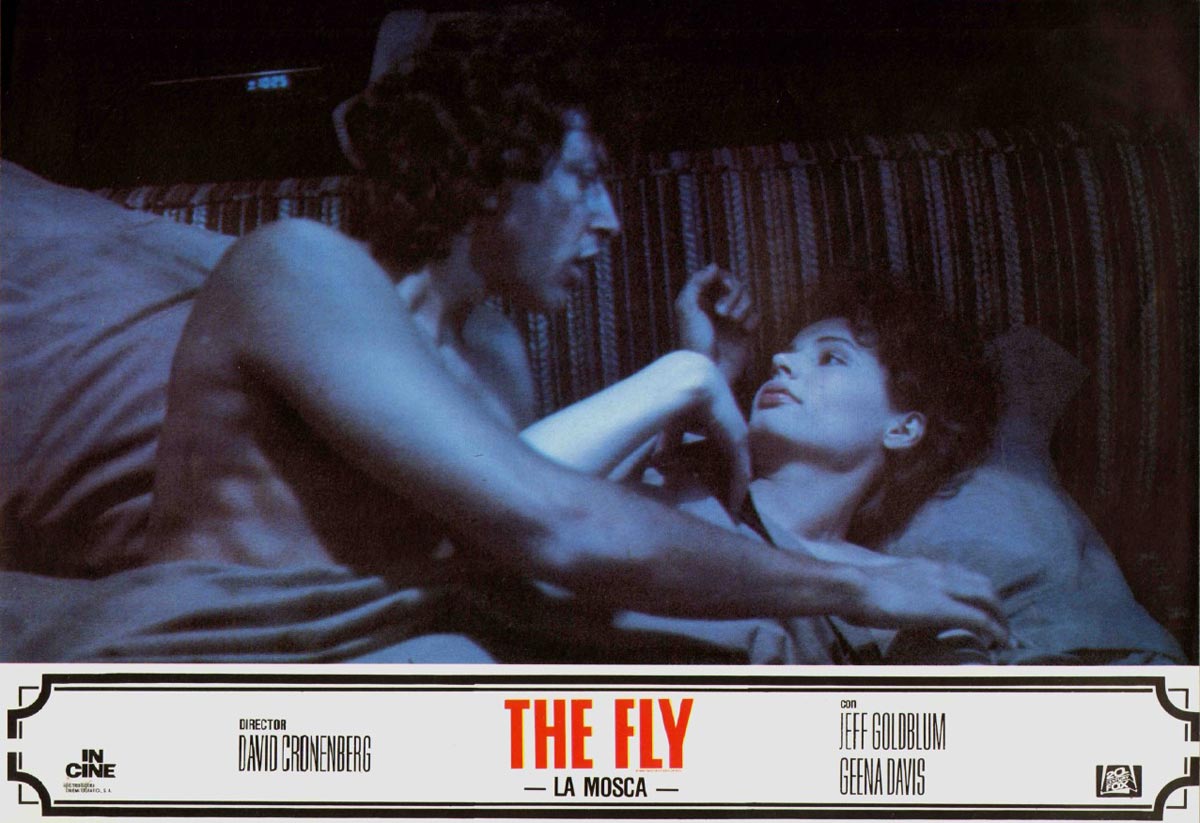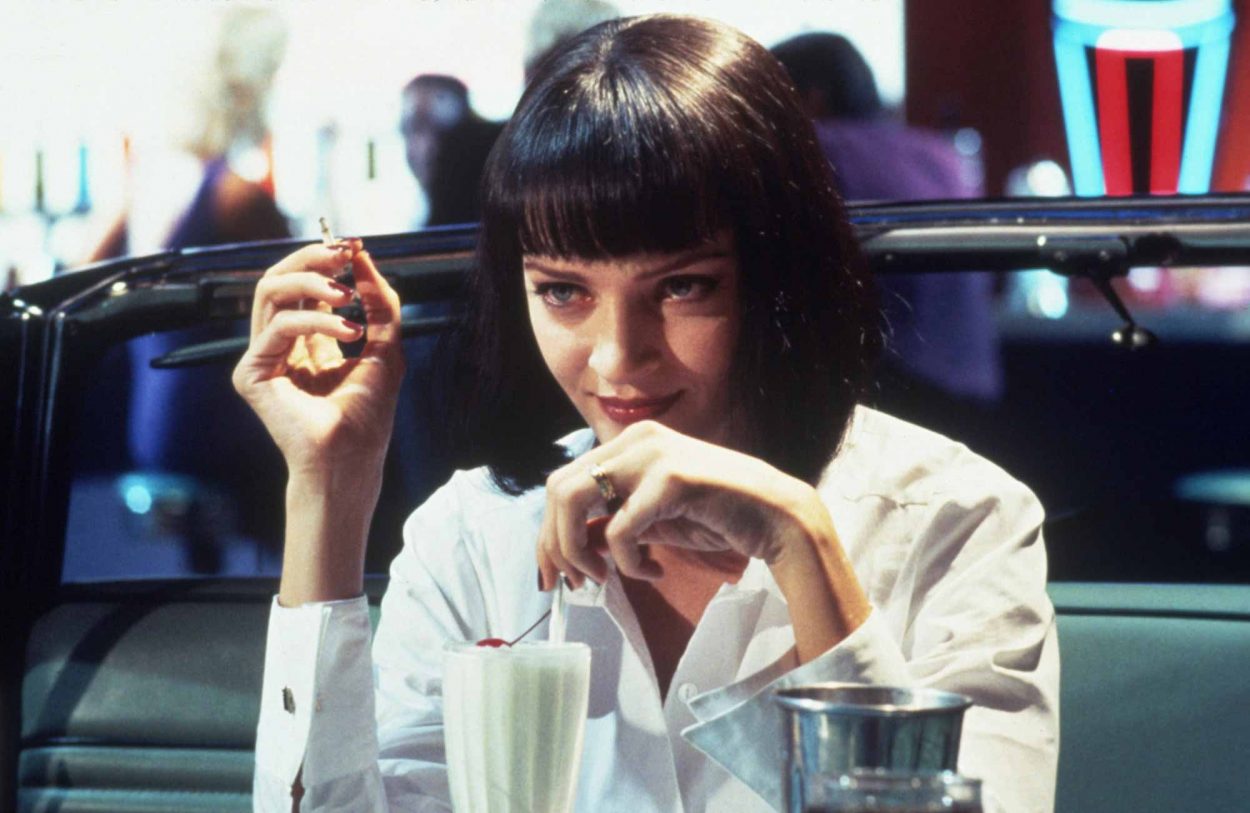The Fly (David Cronenberg, 1986) is one of the most romantic movies ever committed to film.
The hell you say?
This is just fact. If someone took me on a date to the New Beverly’s midnight show of The Fly on July 8th, we might be talking chapel in Vegas for that second date. No two ways about it, this film is the quickest way to my heart.
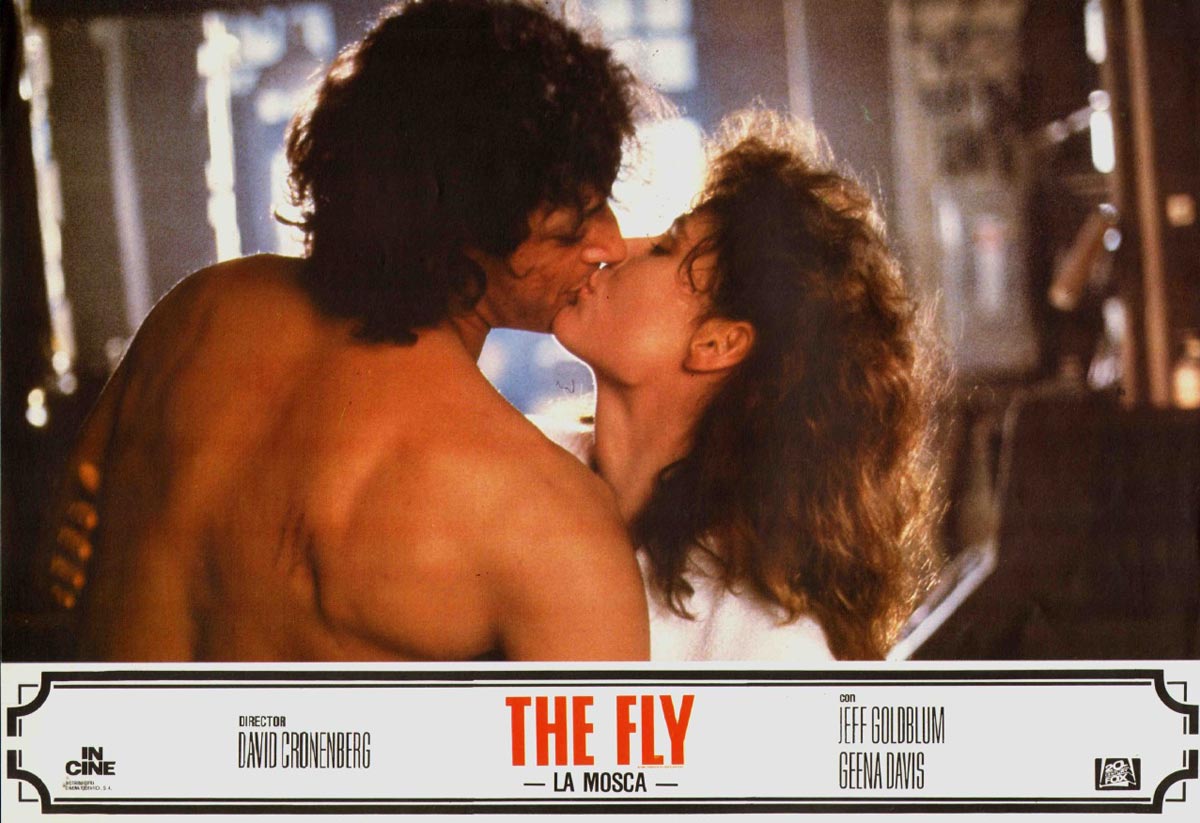
Sexy, emotional, gleefully nauseating and challenging, this highly original take on the 1958 Vincent Price film is one of a kind. There is something aggressively shattering about bearing witness to the joyful romance of scientist Seth Brundle (Jeff Goldblum) and journalist Veronica/Ronnie Quaife (Geena Davis) while watching Brundle’s total physical breakdown from a science experiment gone wrong. His determination and deterioration in this film drive me absolutely bonkers. As Brundle dispenses with each various layer of human “ness,” he also gains a new membrane of Brundle-Fly. At each stage of this process, Brundle-the-scientist is passionately excited and fascinated while Ronnie-the-lover is getting more terrified and yet more emotionally involved. Sickness and science are two of Cronenberg’s favorite playthings and they have never been better utilized to showcase pathos and human fragility than in this film.
“I didn’t realize we were working on a love story. I thought we were working on a horror movie.” – Carol Spier, production designer on The Fly
While it may seem strange that Mel Brooks was one of the producers of The Fly, some may recall that he was also behind David Lynch’s The Elephant Man (1980). As Stuart Cornfield and others recall about Brooks’ involvement, he had one major priority: good audience response. Solid audience reaction. The complicated production of The Fly switched directors, screenwriters, and changed the screenplay at least twice, concluding with Cronenberg as Man of the Hour, for screenplay duties and as director. Straight off the heels of his unfortunate conflict with Total Recall (Paul Verhoeven, 1990), Cronenberg saw The Fly as an opportunity to regain some territory and creative space. The Total Recall thing had been a disaster. David had spent ages writing a script, and designing elements for the film but finally left based on the fact that they wanted something completely different. However, his legacy on that film remains and you can see it at the New Bev on July 28th. All the mutant-type critters? Sooooo Cronenberg.
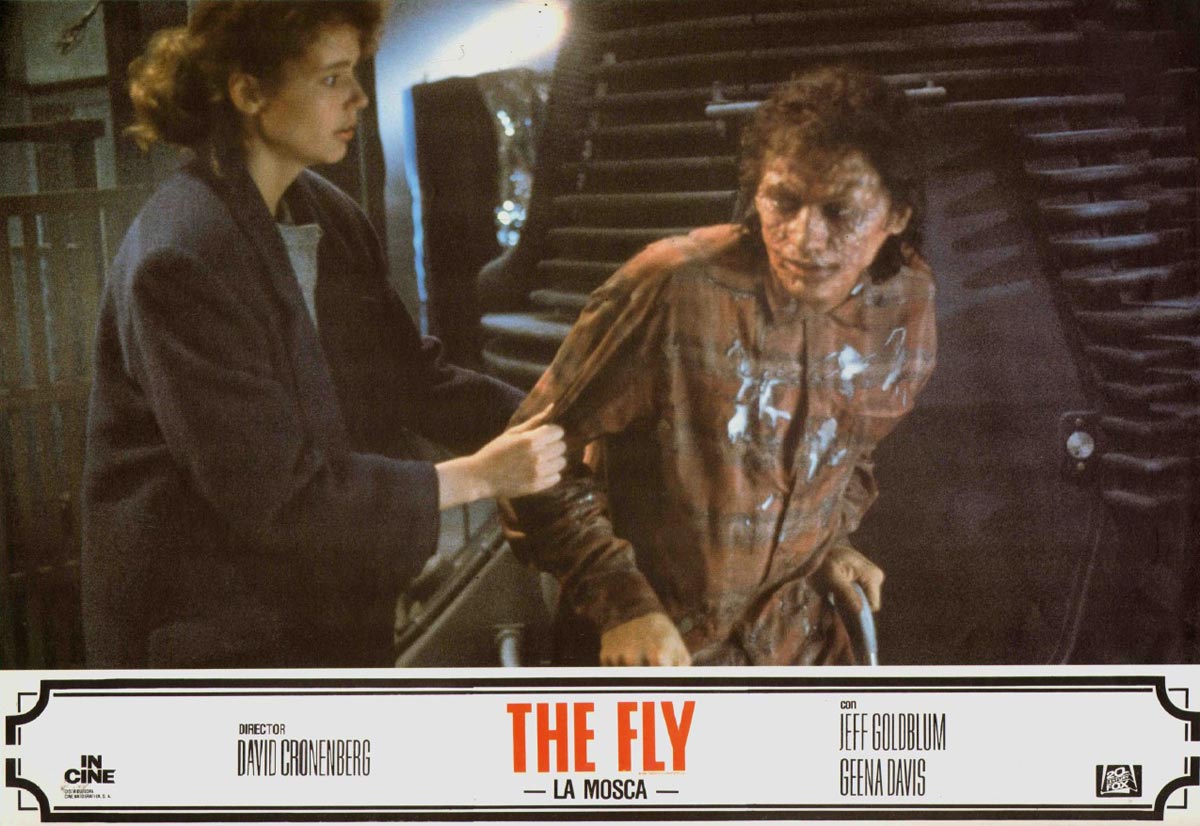
Aside from its technical achievements, The Fly remains unique in the way that it handled character development and the progression of interpersonal relationships. At the time of shooting, Geena Davis and Jeff Goldblum were romantically involved so the chemistry that flies off the screen like heat-seeking missiles is 100% genuine. But the way in which the awkwardness of Seth Brundle and the sharp, no-bullshit Ronnie Quaife are managed is complete magic. It plays, often times, like an erotic screwball comedy, reminiscent of the quirky Professor/Scientist trope so lovingly depicted in films like Bringing Up Baby (Howard Hawks, 1938) or Monkey Business (Howard Hawks, 1952). In fact, Jeff Goldblum has said that he modeled some of the charm and offbeat appeal of Seth Brundle on Cary Grant, so those films are easily early models for this Cronenberg work.
While The Fly is certainly not played for laughs and has none of the cheer and simple joy of a screwball comedy, the structural assets of that genre play strongly in setting up the romance and love story. There is the buffoonish ex-boyfriend, Stanis Borans (played masterfully by John Getz), eccentric-but-endearing Seth Brundle mannerisms (including piano playing and piano-jokes) and, most importantly, quick-paced dialogue between the couple based upon the oddball scenario in which they’re involved. And if you know about screwball comedies, there is always an oddball scenario. All of these things are hooks, and we the audience are the fish. After the love/romance is firmly established however, get your ass locked in, cats and kittens, it’s going to be a helluva ride.
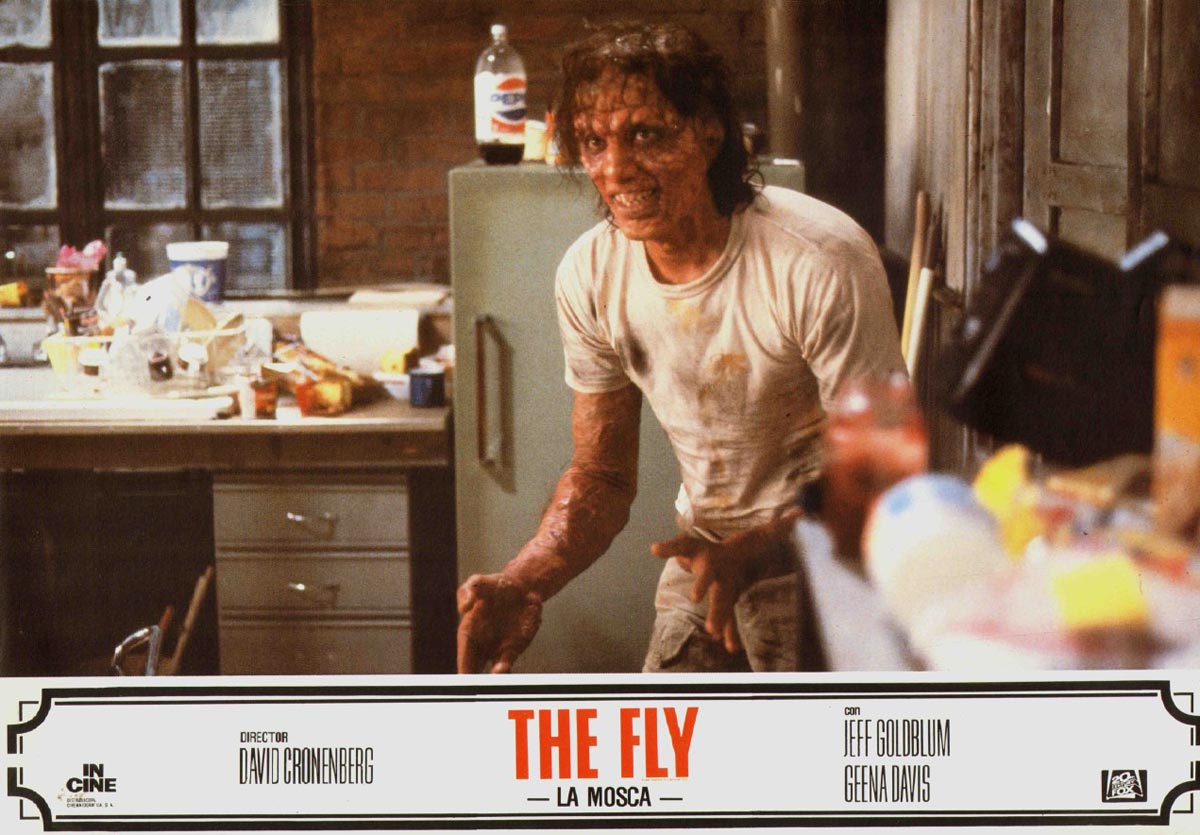
“I feel sick to my stomach, it’s great!” – on-set crew comment when asked how a shot looked.
This film, this horror-romance-drama, constructs a “what would happen if” situation. Seth Brundle has made a grave scientific error, catalyzed by allowing himself to become over-emotional. His drunken jealousy made him sloppy (as drunkenness tends to do) and it essentially kills him. The science man, ruled by facts and figures, makes a fatal error due to feeling too much. Oh the irony!
The Fly deeply examines science and experimentation practices, human physiognomy, diseased flesh and its cellular breakdown. Cronenberg has rejected the theory that this film was a corollary or a parallel to the AIDS epidemic, raging in full force in 1986 and a topic that many people were wont to compare the film to. He spoke of the film in terms of its relationship to aging and getting closer to death and that manner of body breakdown- hair and teeth loss, shift in physical stature, inability/loss of ability to hear or speak. All of these things are present within The Fly.
Davis and Goldblum have both remarked in various interviews that Cronenberg suggested that they consider Seth Brundle’s deterioration and their characters’ relationship as parallel to a couple who has to deal with a cancer diagnosis, care-taking and all the various stages that the disease-ridden body might go through in that fight. Whether it is the aging process, AIDS, or cancer, the relationship that evolves from the literal muck of Seth Brundle’s decrepit body is one that holds tight to ideas of love and empathy. Ronnie’s sensitivity to the most grotesque of Seth’s moments is a testament to how much she is willing to do or put aside for a partner or lover. It is this, amongst the fingernails, bits of hair and sugar-drenched food strewn across the screen, which makes the audience remember that this is indeed a love story, no matter what.
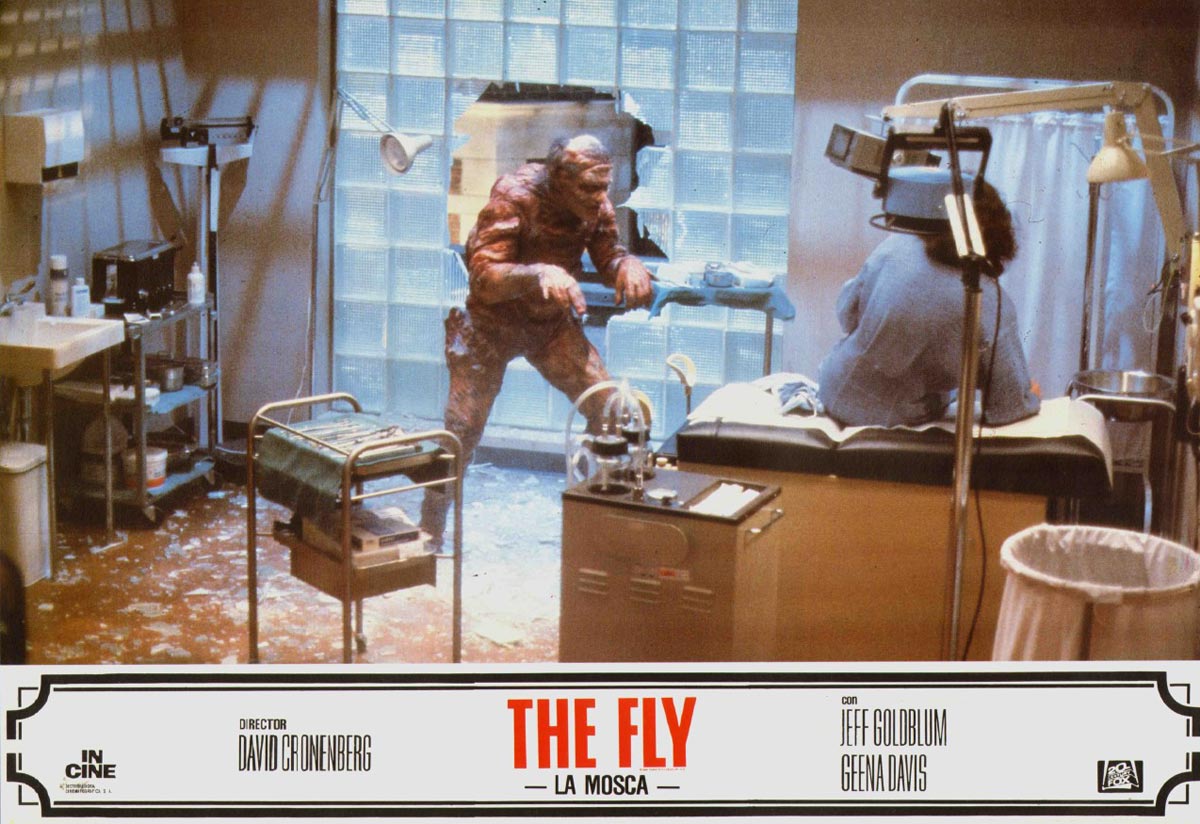
“Everyone working on the film was a fan of Cronenberg, so they just understood it was going to be wet!” – Stuart Cornfield, producer of The Fly
As I discuss in my previous piece on David Cronenberg and his films, they get very messy. They are filled to the brim with disease, chock full of bodily fluids, and elegantly draped in the splattered mess of what we exude and what we are made out of. The Fly gets an extra level of mess because it explodes with emotion at every turn. Linda Williams, leading feminist film scholar, made huge in-roads in genre discourse when she termed “body genres,” a category that has greatly informed my film sense over the years. The Fly is not only a body genre picture, but it combines body genres. As Williams defines it, the primary locus of the body genre world exists in horror, melodrama and pornography. These specific areas are considered “body genres” because they work upon the idea of excess and physical response. Williams writes, “Visually, each of these ecstatic excesses could be said to share a quality of uncontrollable convulsion or spasm-of the body ‘beside itself’ with sexual pleasure, fear and terror, or overpowering sadness. Aurally, excess is marked by recourse not to the coded articulations of language but to inarticulate cries of pleasure in porn, screams of fear in horror, sobs of anguish in melodrama…the success of these genres is often measured by the degree to which the audience sensation mimics what is seen on the screen. Whether this mimicry is exact, e.g., whether the spectator at the porn film actually orgasms, whether the spectator at the horror film actually shudders with fear, whether the spectator of the melodrama actually dissolves into tears, the success of these genres seems a self-evident matter of measuring physical response.”
So why does The Fly work so goddamn well? Because just at the point you’re feeling a little sexy, you start feeling a little terrified. Then at that heart-stopping point of terror, you get to the juncture of the film where you feel like you really shouldn’t have eaten before seeing this film because OhMyGodIThinkIWantToPuke, can I really be seeing something that excessively gross on screen in the same movie that just made me wanna get busy? Then, like a big fucking hurricane, you’re crying. Because you can’t help it. These people, this relationship, this narrative…you CARE. You actually have (maybe) seen beyond the discarded limbs and pus-filled fingertips, you now see the humanity in the illness and you see the epic tragedy that is now the lives of both Ronnie and Seth Brundle (well on his way to being Brundle-Fly).
The conclusion of the film presents us with the classic Cronenberg dilemma: kill it with fire or fuck/love it forever? Geena Davis says that shooting these tragic final scenes was incredibly grueling. Not only is this section of the film incredibly FX-intensive but it is 100% emotionally obliterating. “I had to cry for basically two weeks. At the end of the two weeks, my eyes were all puffed up and swelling,” Davis recalls. Having gone through the entirety of a film watching the relationships grow and evolve- Ronnie/Seth, Seth/Brundle-Fly, Ronnie/Brundle-Fly, we can do nothing but watch with a mix of horror and our own sense of devastation during this final act. While Cronenberg and his FX team did a magnificent job of evolving Seth Brundle into Brundle-Fly, it is the final annihilation of Seth that causes the film to burst itself wide open into floodgates of excess: blood, vomit, fly-acid, tears, screaming. The finale reads as a panoply of pain, addressed to absolute perfection by everyone involved. There is genuinely nothing like this film or the final sequence. This is human emotion and fragility in its purest, most naked form.
